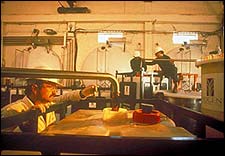Making ethanol is a bit like following a recipe from an old Farmer’s Almanac: Grind corn into flour; add water and enzymes to turn the flour into sugar; add yeast until you have a syrupy concoction; strain the solids out; distill. Essentially, ethanol is a taste-bud killing moonshine with a 200-proof kick. Pour at least two-to-five percent gasoline into the mix and the low-budget liquor becomes usable in a gas tank. With the proper permit and a bit of time and effort, you could produce ethanol at home in your very own still. But considering the increasing availability of this cost-efficient green fuel at stations around the country, you’ll probably never want to.
For more information on ethanol:
Contact the American Coalition for Ethanol(605-334-3381, ) or the American Council for an Energy-Efficient Economy (202-429-8873, ) Making ethanol, Courtesy Iogen Corporation
Making ethanol, Courtesy Iogen Corporation
Election-year politics have brought ethanol into the limelight recently, with candidates hoping to woo Iowa corn growers before the straw polls, but an ongoing debate continues over its effectiveness and environmental benefits. Proponents say that widespread use of E85 (an 85 percent ethanol, 15 percent gasoline blend) could significantly reduce both oil imports and carbon dioxide emissions. But skeptics argue that the production of today’s ethanol, mostly made from milled corn kernels, burns fossil fuels and produces only 30 percent more energy than it takes to make.
Ethanol can be created from any starch or cellulose, and scientific and environmental organizations contend that “cellulosic” ethanol, made from crop wastes or grasses, will become a valuable source of energy once technology evolves to make it cheap enough to mass-produce. Cellulosic ethanol also has a slew of environmental benefits: up to eight times more energy than corn ethanol, low impact on water, soil, and air quality, and the ability to be manufactured from naturally-grown and widely available materials like prairie grass.
While companies like , a Canadian biofuel company, research ways to make cellulosic ethanol commercially viable, corn-based ethanol is only affordable to consumers through tax subsidies. E85 currently costs only a few cents more per gallon than gasoline and is much higher octane, with a rating of 105-to-110 as opposed to 87 (the average for regular unleaded gasoline). But E85 provides only about 75 percent of the energy of gasoline. This means higher per tank prices along with limited mileage ranges. Ethanol-optimized vehicles (capable of running only on ethanol) do, however, achieve gas mileage superior to that of gasoline-powered engines.
Unfortunately, many consumers who could be using ethanol aren’t aware it exists. Currently, the auto industry offers at least 20 different models of cars and trucks capable of using E85 without modification, like Ford’s Taurus and Explorer, Chevy’s Silverado, and Dodge’s Caravan. Labeled “flex-fuel,” these vehicles account for more than three million autos on the road, and across the U.S. more than 240 gas stations offer an E85 pump. But the Department of Energy estimates that only 82,000 drivers have ever filled their tanks with E85. Why the lack of interest? Jim Kliesch, research associate at the American Council for an Energy-Efficient Economy, says very few flex-fuel owners know that their cars are capable of fueling up on the fruits of the Heartland. ()
Ron Lamberty, interim executive director of the South Dakota-based American Coalition for Ethanol, and the owner of two flex-fuel vehicles—a Chevy Tahoe and Ford Taurus—touts E85 as an answer to the country’s reliance on foreign oil. “Aside from the clean-air benefits, every gallon of E85 means it’s one less gallon of oil we have to buy from outside the country,” he says.
Added bonus: Since ethanol burns at a lower temperature than gasoline, it incinerates more completely, reducing the particulate matter in auto exhaust. Increased use of the starch-derived fuel could help U.S. cities like Houston— which has held the Environmental Defense Fund’s dubious distinction of “America’s Smoggiest City” since 1999— to clean up their acts.
Want to find out more? Check out our green fuel guide:


